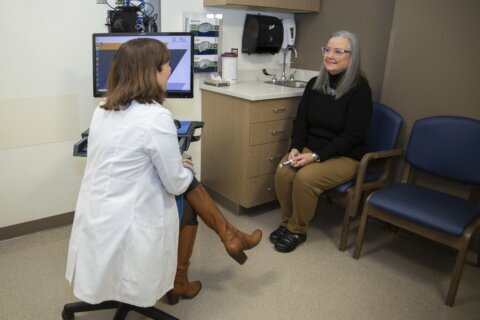WASHINGTON — When Robert Branson reached a certain age, he noticed a dramatic change in the conversations he had with his friends after a routine round of golf.
“We used to talk about booze and broads, and now we talk about medical things,” says Branson, 66, of Bethesda, Maryland. “When you cross over to the dark side, which is [when you’re] eligible for Medicare, your focus becomes more medically oriented than you would believe.”
With health on the top of his mind, Branson enrolled in a concierge medical practice, where, for about $150 a month, he has somewhat unlimited access to, and time to spend with, his primary care physician.
“I’ve got [my doctor’s] personal cellphone number — never had that from a doctor before,” says Branson, who also emails back-and-forth with his physician. “That kind of peace of mind is comforting.”
In the U.S., concierge medicine — also called “boutique” or “personalized” medicine — is growing fast. The American Academy of Private Physicians says about 4,400 doctors were practicing some form of concierge medicine in 2012 — a 25 percent increase from the previous year.
In December 2014, Dr. Jim Williams joined the expanding number of primary care doctors transitioning into personalized care when he opened his own concierge practice, Total Primary Care, at Sibley Hospital, in Northwest D.C.
His principal reason for leaving the traditional model of health care behind was to spend more time with his patients — a main selling point of most concierge practices. To do so, he keeps his patient numbers low.
“Our practice will never be more than 600 patients per doctor,” Williams says. “The average, if you were to go to your typical primary care office, each doctor might have 3,000 or 3,500 patients.”
That’s where the $150 monthly fee comes in to play. Williams explains that in managed care, doctors are only paid when they see patients in the office for a visit.
“A medical practice would never be viable if it only had 600 patients and only received the revenue that insurance companies pay,” he says. “If a doctor takes a phone call, or spends extra time with the patient, or spends perhaps extra time explaining the patient’s situation to a family member, sometimes medical practices frown on that because it’s not a revenue generator.”
With personalized care, patients pay a fee that helps to float the costs for the things insurance doesn’t reimburse, such as house calls and extra time spent during office visits. This frees up a doctor’s schedule and allows each patient to receive more time and attention.
“There’s nothing worse than feeling like you’re on a treadmill and need to see a patient every 15 minutes, or every 12 minutes,” Williams says.
“I think the physicians like it because we get more time with our patients; we get more of an opportunity to put our knowledge and expertise to work in a meaningful way. And being able to spend more time is very rewarding for us.”
Williams says it was difficult to find a concierge practice in D.C. about 10 years ago. That is no longer the case — and a number of factors are contributing to the boom in concierge medicine. For starters, baby boomers are entering the age at which they require more care. This is placing a huge demand on physician services.
At the same time, there is a shortage of primary care physicians in the country; experts predict the need for an additional 50,000 in the next 10 years, The Atlantic reports. But a survey of third-year medical students found that only 20 percent planned to enter into primary care.
Physician retention is a concern as well. A study of 500 primary care doctors found that 30 percent of those aged 35 to 49 planned to leave their practices within five years. For older physicians eager to cut back their hours in anticipation of retirement, that rate jumped to 50 percent, The Washington Post reports.
The influx of millions of newly insured Americans also adds a stress to the system, Williams says.
Could a thing of the past become a model for the future?
Concierge medicine is not for everyone, Williams admits. Those who are young and healthy and only see a doctor one or two times a year for an acute illness likely won’t see a value in the model. But the aging population, or those with chronic illnesses, will likely benefit from the extra care offered — whether that’s time spent explaining a cholesterol test, helping a cancer patient navigate the appropriate specialists to see, or making house calls — something Williams does often.
“That can be such a difference-maker — to see a person in their home environment is so helpful to see what’s really going on in their life. This is often the case with some of our older patients, to see how the home is and how they’re getting about their daily life,” Williams says. “In traditional medicine, doctors are hard-pressed to ever find the time to really do it.”
Branson recently watched a good friend and patient of Williams’ go through what he describes as “the whole medical practice of dying.” He says Williams would drop by his friend’s house on his way home from work a few times a week to sit with him.
“That’s the way it was when I was a little boy and Dr. Sweeny used to come by my house and take my temperature. So in some ways, it’s medicine as it used to be, but I think it’s really medicine of the future,” Branson says.
Critics of concierge medicine say the model creates a two-tier health system, making exceptional care available only to those who can pay for it, The Atlantic reports.
But Branson argues that concierge medicine is not elite medicine.
“It doesn’t cost any more than a latte a day … And it doesn’t add hugely to the cost of medicine. Medicare and Medicaid still pay for everything; you just have this one-latte-a-day pay for the peace of mind of always knowing you’re going to get a great answer from a doctor,” he says. “It’s beyond getting your money’s worth.”
Personalized medicine is becoming more democratized as demand grows. Some concierge practices are even starting to offer their services at a lower cost than previous years.
“I think going forward in the next few years, people are really going to notice a change in their health care – not that it’s going to deteriorate in quality … the speed with which it will all take place is going to be a challenge. So I think the comfort factor of this is really worth all the effort,” Branson says.







